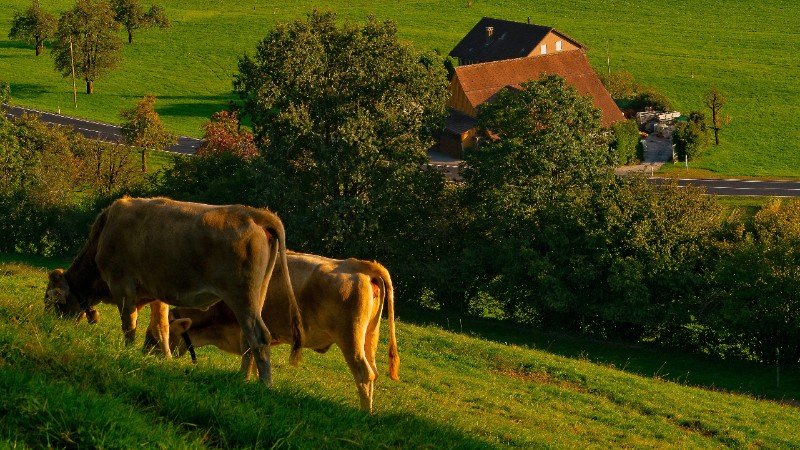How To Choose The Right Crops Or Livestock For Your Farm & Climate?

Choosing the right crops or livestock for your farm is a crucial aspect of successful farming. A region’s climate and weather patterns significantly impact the growth and productivity of crops and livestock. Before deciding, farmers must consider various factors like soil type, water availability, and temperature. In this article, we will discuss how to choose the right crops or livestock for your farm and climate. By understanding the interplay between the climate and the crops or livestock, farmers can make informed decisions that lead to a successful and profitable farming operation.
To choose crops or livestock, consider your region’s climate, weather patterns, soil type, water availability, and temperature. Use the USDA hardiness zone map to understand your average annual minimum temperature. Also, consider precipitation patterns, seek advice from local experts, and assess the past performance of crops in your area.
A crucial aspect of choosing the right crops or livestock is understanding the climate zone in which your farm is located. Different crops and livestock thrive in different climate conditions, and knowing which plants and animals are best suited for your region is essential. The USDA hardiness zone map provides farmers with valuable information about their area’s average annual minimum temperature, which is a key factor in determining what crops or livestock can be grown. Additionally, understanding the precipitation patterns, including the amount and timing of rainfall, is crucial for ensuring that your crops or livestock have adequate water for growth.
How to choose the right crops or livestock for your farm?
Choosing the right crops or livestock for your farm is a critical decision that can impact the success and profitability of your agricultural business. The key to making the right choice is considering several factors, including your local climate and soil conditions, market demand, and personal preferences and skills. Here are some steps to help guide you through the process.
Conduct a thorough analysis of your local climate and soil conditions
Before choosing any crops or livestock, it is essential to understand the conditions of your local environment. This includes the climate, soil type, and soil quality. The ideal crops or livestock for your farm will depend on these conditions.
For example, if you have a warm and humid climate, crops such as rice, soybeans, and cotton may thrive, while a colder and drier climate may support crops such as wheat, barley, or corn. Understanding your soil type and quality will help you determine which crops will grow best on your land.
Research market demand
Another crucial factor to consider is your area’s demand for crops or livestock. Before making any decisions, research what crops or livestock are in high demand in your local market and what prices they fetch.
You can also consider trends in consumer demand, such as the popularity of plant-based diets or the increasing demand for organic products. This will help you decide what crops or livestock to grow or raise on your farm.
Consider personal skills and preferences
Finally, it’s essential to consider your skills and preferences when choosing crops or livestock for your farm. Consider what kind of work you enjoy and what skills you have.
For example, if you have experience raising livestock, it may make sense to focus on raising cattle or sheep, while if you have a green thumb, you may prefer to grow crops such as vegetables or fruit. Consider your financial goals and resources, as some crops and livestock may require more investment upfront or have higher ongoing costs than others.
Impact of climate on choosing crops or livestock for your farm
Climate plays a crucial role in determining crops or livestock that can be successfully grown or raised on a farm. Different regions of the world have unique climatic conditions, and the ideal crops or livestock for a farm will depend on the local climate. For example, rice, soybeans, and cotton crops may thrive in warm and humid climates, while wheat, barley, or corn may be more suited to colder and drier climates.
The climate also affects the growing season for crops and the availability of feed for livestock. For example, regions with long growing seasons may grow multiple crops in a year, while regions with shorter growing seasons may only be able to grow one crop. Similarly, regions with abundant rainfall may be able to support larger herds of livestock. In contrast, regions with limited rainfall may require the use of irrigation to grow crops and provide water for livestock.
Additionally, the climate can affect the resistance of crops and livestock to pests and diseases. Some crops and livestock may be more susceptible to disease and pests in certain climates, while others may be more resistant. This will impact the success and profitability of your agricultural business, as diseases and pests can reduce crop yields and harm the health of your livestock. It is important to carefully consider the climate when choosing crops or livestock for your farm, as it can significantly impact the success and profitability of your agricultural business.
What crops are good for climate change?
Crops that are good for climate change can withstand and adapt to changing weather patterns, extreme weather events, and increased temperatures. Some examples of these crops include:
- Drought-resistant crops: Crops such as sorghum, millet, and cassava are known for their ability to withstand drought conditions, making them suitable for regions with limited water resources or periods of drought.
- Salt-tolerant crops: As sea levels rise and coastal regions become saltier, crops such as barley, rice, and wheat that are tolerant to salt are becoming increasingly important.
- Heat-tolerant crops: As temperatures rise, crops such as maize, soybeans, and cotton that can tolerate higher temperatures will become increasingly important.
- Pest-resistant crops: Some crops, such as genetically modified crops, have been engineered to resist pests and diseases. This reduces the need for pesticides and herbicides, which can have negative environmental impacts.
These crops are good for the environment because they help to reduce the use of pesticides and herbicides, conserve water resources, and reduce greenhouse gas emissions from agriculture. They also help to ensure food security by providing stable yields even in the face of changing weather patterns and increased temperatures.
By growing crops well-suited to local conditions and that can withstand the impacts of climate change, farmers can help mitigate the effects of climate change and ensure the sustainability of their agricultural businesses.
Selecting livestock based on your climate and land availability
When selecting livestock for your farm, it’s important to consider both the climate and the availability of land. Different animals have different requirements for temperature, humidity, and pasture space, so it’s important to choose the right species to thrive in your area. Here are two key factors to keep in mind when choosing livestock.
Climate
The climate in your area plays a big role in determining what kind of livestock you can raise. For example, in hot and humid climates, it’s important to choose breeds that are well-adapted to these conditions. Breeds like Brahma and Jersey are well-suited for hot climates, as they have a good tolerance for heat and can be raised in various environments.
On the other hand, in cold climates, breeds like the Angus and Hereford are better suited, as they have heavier coats and can better withstand cold temperatures. It’s important to research the climate requirements for different breeds of livestock and choose the one that will be most successful in your area.
Land Availability
Land availability is another important factor to consider when choosing livestock. Some animals require more pasture space than others, and it’s important to have enough space to accommodate the animals you plan to raise. For example, cows require more space than chickens, and chickens require more space than rabbits. When choosing livestock, it’s important to consider the size of your land and the amount of pasture space available.
If you have limited space, you may consider raising smaller livestock like rabbits or poultry in a coop instead of on pasture. It’s also important to consider the zoning laws in your area, as some regions restrict the number of livestock that can be kept on a property.
Understanding your local climate and soil conditions
Understanding your local climate and soil conditions is crucial for choosing the right crops or livestock for your farm. The climate determines the type of crops or livestock that will thrive in your area, as different species have different temperature, rainfall, and atmospheric conditions requirements.
To determine your local climate, you must consider factors such as the average temperature, rainfall patterns, humidity levels, and wind patterns. This information can be obtained from local meteorological stations, and it is important to consider the variability and frequency of extreme weather events such as drought or heatwaves.
The soil conditions also play a key role in determining the suitability of your farm for a particular crop or livestock. Soil type, fertility, pH, drainage, and other factors are important considerations when choosing crops or livestock. The soil type and fertility can be determined by conducting a soil test, which a local extension service or a private laboratory can do.
Preparing for climate change and its impact on your farm
As the world faces the reality of climate change, it is increasingly important for farmers to consider its potential impact on their operations. This includes changes in temperature, precipitation patterns, and extreme weather events that can significantly impact crops and livestock.
One of the ways farmers can prepare for the effects of climate change is by choosing crops and livestock that are better suited to the local climate and soil conditions. For example, planting drought-resistant crops or choosing heat-tolerant livestock breeds can help mitigate the effects of climate change on your farm.
Another important aspect of preparing for climate change is being proactive in the face of extreme weather events. This may include developing contingency plans for dealing with droughts, floods, and heatwaves or investing in infrastructure that can help protect crops and livestock. For example, implementing irrigation systems, constructing greenhouses, or investing in shelters for livestock can help protect against the impacts of climate change.
Farmers can also consider reducing their carbon footprints, such as implementing sustainable practices, reducing waste, and conserving energy, which can help mitigate the impact of climate change on their farms and the wider environment.

